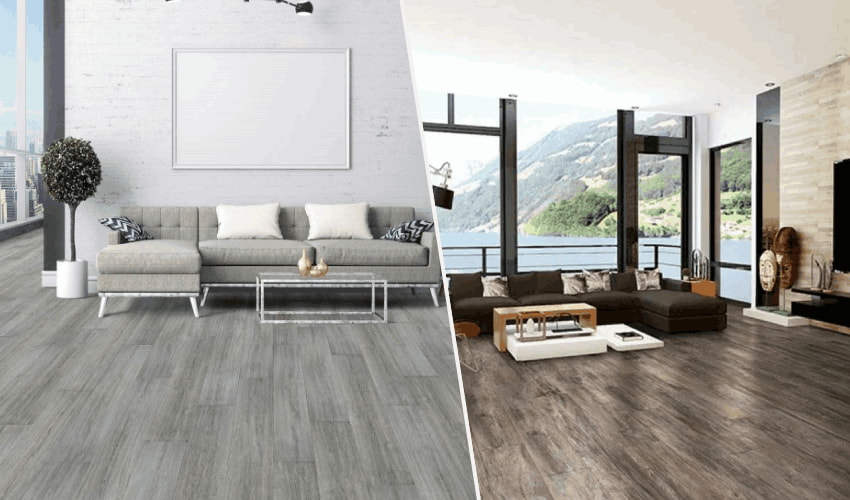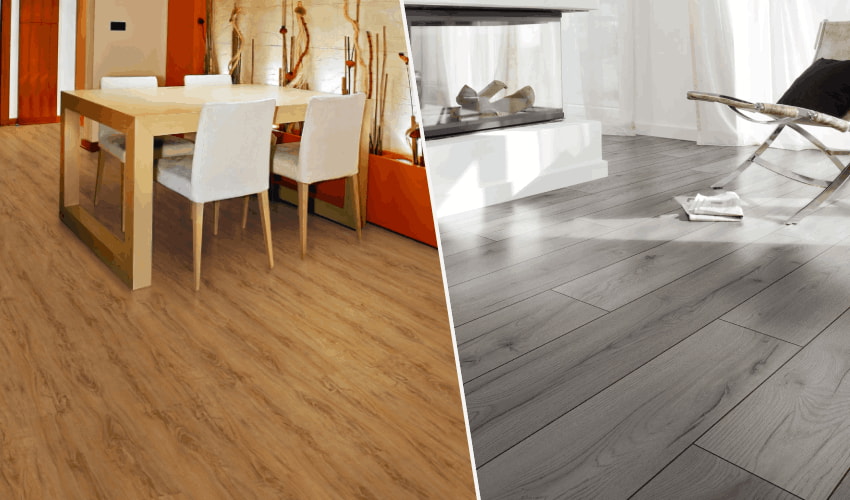The floors of your residential and commercial spaces make a significant impact on the overall appearance of your property. When you are after the most appealing, economical, and durable floor options for renovations, laminate and vinyl floors are the two most popular and widely selected materials. For some people, both have just the name differences but when you get to know these terminologies in detail, the reality is different.
Neither of these two options is better from all the aspects and categories. If you are planning to renovate your floors with any of these options and are indecisive about choosing the better one, then you’ve come to the right place. In this blog by Dubai Carpenter, we have summarized all the major differences between floor treatments to help you make an informed decision.
What Is Vinyl Flooring?
Made from synthetic materials, vinyl plank or tile flooring is composed of four different layers serving different functionalities to contribute to the stability of the floors. With wear, print, core, and backing layers, this flooring is the best option for both residential and commercial applications.
What Is Laminate Flooring?
Laminate floors are also constructed using synthetic materials, featuring distinct layers including core, backing, decorative, and fiberboard layer. These layers are firmly sandwiched together through a lamination process. This floor treatment is best suited for most of the residential applications.
Explore Prominent Differences Between Laminate & Vinyl Flooring
Down here, we’ve compared the differences between these purposeful floor choices in terms of functionalities, costs, and maintenance. Let’s dive into the details for the best pick.
1. Appearance & Comfort
Vinyl Flooring
Vinyl floors probably look like a solid or homogeneous material but their planks are tiles manufactured with the combination of different layers. With top clear wear, high-definition photographic, thick core, and soft foam bottom layer, it creates a cushioned surface. The photogenic layer gives realistic visuals of luxury wood species, stone, and ceramic materials.
Laminate Flooring
On the other hand, laminate planks Flooring are composed of five layers including top wear and image, photographic wood or stone, thin impact-resistant, heavy-duty HDF board, and a final soft foam backing layer. It mimics the appearance of real wood or stone, featuring hand-scraped, multi-tonal, rustic, reclaimed wood, and natural finishes.
2. Stability Against Foot Traffic
Vinyl Flooring
Floors’ stability can be checked based on their sustainability against daily wear and tear. When you select vinyl planks or tiles, they show excellent durability in spaces with the highest volumes of foot traffic and humid areas. No matter, whether it’s a residential or commercial space, vinyl offers high performance in your spaces.
Laminate Flooring
Laminate planks are also a durable choice for residential applications. This floor treatment is restricted to a light volume of foot traffic and low-moisture areas. It can hold up against wear and tear but in the short term as compared to vinyl, making themselves best for all kinds of residential indoor and outdoor applications.
3. Design & Texture Choices
Vinyl Flooring
When it comes to vinyl flooring, you have a wide range of options to discover for their unique patterns and textures. Made from wood and solid plastic composite materials, their planks exhibit various unique patterns on their photogenic layer. For this exclusive treatment, you have extensive texture options including Wire brushed specific species graining, hand-scraped, matte finish, high gloss, and natural stone, including both smooth and rough textures.
Laminate Flooring
On the other hand, you can also find various contemporary options for laminate planks as well. With an individuality of styles, you can pick from various layouts that perfectly suit the ambiance of your space. For your residential and commercial space renovations, you can select from the distressed, hand-scraped, smooth, satin, or high-gloss, and grainy finishes, featuring sophisticated appearances.
4. Potential & Environmental Factors
Vinyl Flooring
The functional aspects are required to be considered in detail to validate the dimensional and structural stability. The flooring must be resistant to moisture, stains, scratches, fade out, and wear or tear, and fortunately, vinyl planks offer practical and dimensional stability against all these aspects. This is why, they can be installed in heavy-traffic areas with humid temperature conditions.
Laminate Flooring
Laminate planks are a great choice for all other aspects except moisture and stains. These planks don’t show excellent resistance against stains, spills, and moisture, hence, it is suggested to install them in places with low volumes of foot traffic and are not prone to moisture and humidity.
5. Installation & Flooring Cost
Vinyl Flooring
It’s a close race when it comes to the evaluation for the most easy-to-install flooring treatment. Vinyl flooring can be installed after the subfloor preparation and fitting rows through a click-lock method. However, it will require fewer tools and basic skills, hence, it is a superior choice in this category and it is DIY-friendly as well. Vinyl planks are way more expensive as compared to laminate flooring.
Laminate Flooring
Laminate planks require the fitting of underlayment and tape seams before installing planks on the floors. By cutting and removing all the obstructions, their planks can be installed, ensuring the connection of end joints. Unlike vinyl floors, it is not DIY-friendly and, hence, requires professional installation. Unlike vinyl planks, it is an affordable floor treatment for any space
6. Lifespan & Resale Value
Vinyl Flooring
Vinyl comes in the form of sheets, tiles, and planks for flooring, varying in longevity a little bit. Depending on their quality construction and proper aftercare, they can last for more than 14-18 years. In addition to that, the resale value of vinyl sheets and planks is lower than laminate.
Laminate Flooring
On the other hand, laminate floors offer a serviceability of 15-20 years depending on the daily wear and tear or utmost care. Aside from that, these planks and tiles command a higher resale value than luxury vinyl Flooring but lower than solid, hardwood, and engineered wood.
7. Maintenance And Care
Vinyl Flooring
The strongest feature of this flooring is that it is simple to care for. This is because it can be wet-mopped and vigorously scrubbed to remove the spills and stains easily and is completely waterproof. You don’t have to clean them frequently to sustain their look as they are dirt and dust-resistant as well.
Laminate Flooring
It is not advised to wet-mop these floors frequently because they are not moisture-resistant. For this floor treatment, you can try dry methods including broom and dry mop to not damage their texture and appearance. However, it is not arduous to keep them clean and maintain.
The Bottom Line!
When it comes to the selection of flooring treatment for your residential and commercial spaces, vinyl and laminate planks or tiles are the two most popular options to settle for your interior style enhancements. Laminate flooring is made from various sandwiched layers, offering durability, versatility, and a sense of luxuriousness to a space.
On the other hand, vinyl flooring is the better option due to its higher sustainability and durability in humid environments. These two floor options with some shared and distinct features are the best options for both residential and commercial applications. Consumers can purchase it considering their unique features and functionalities mentioned in this piece of writing.













